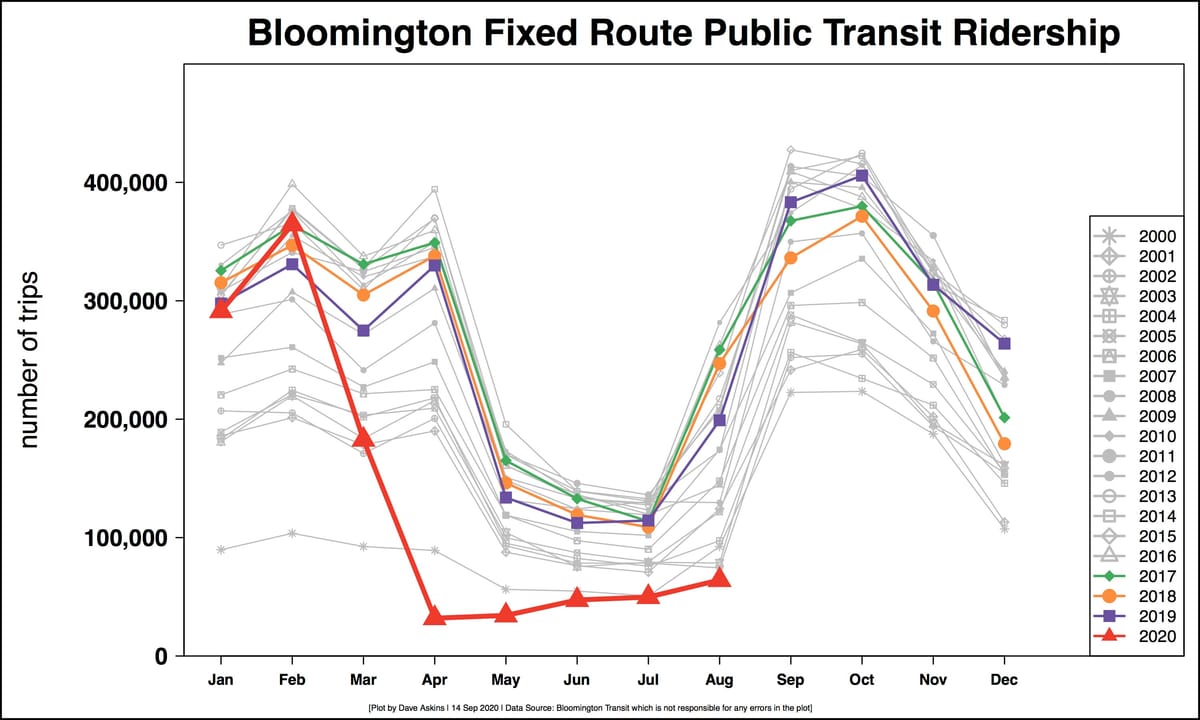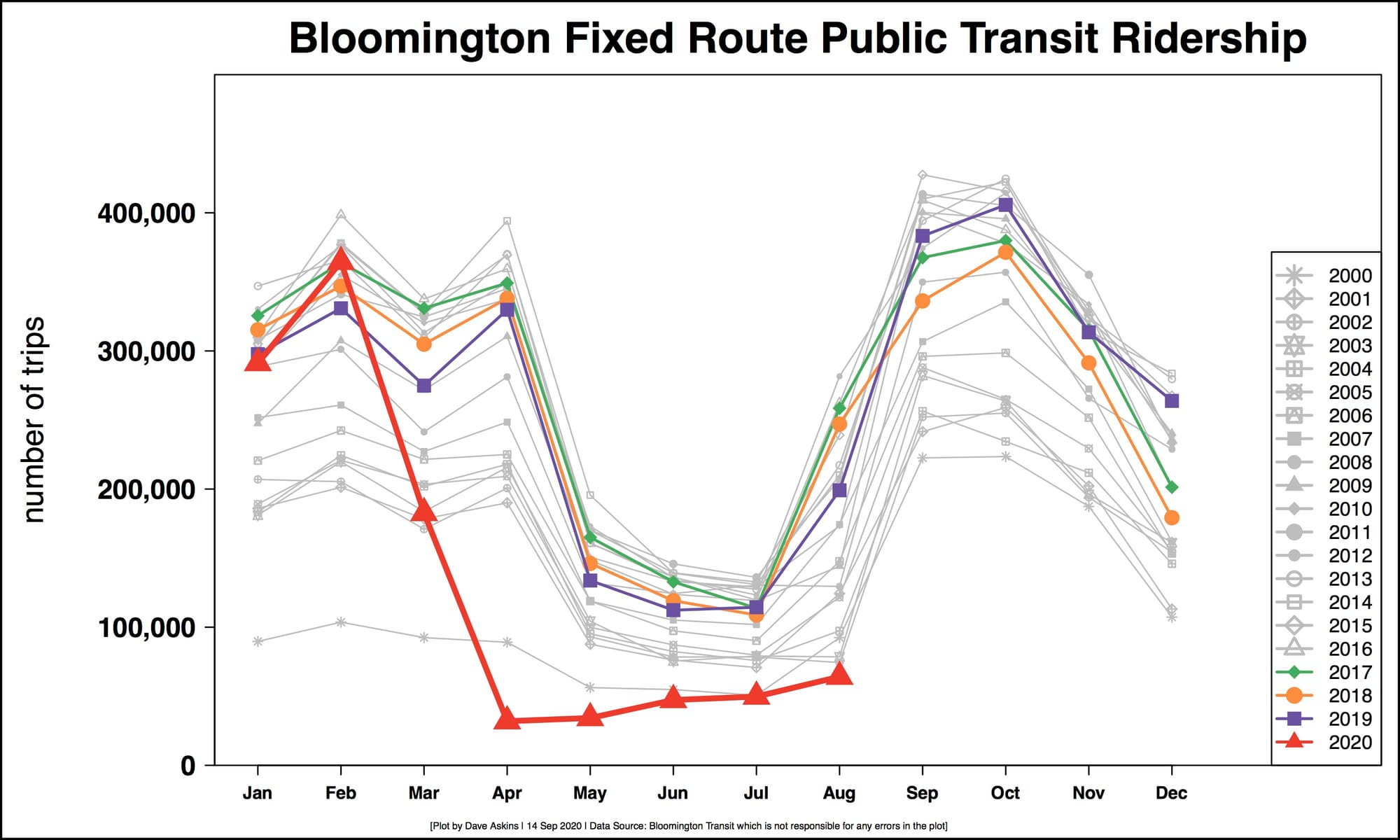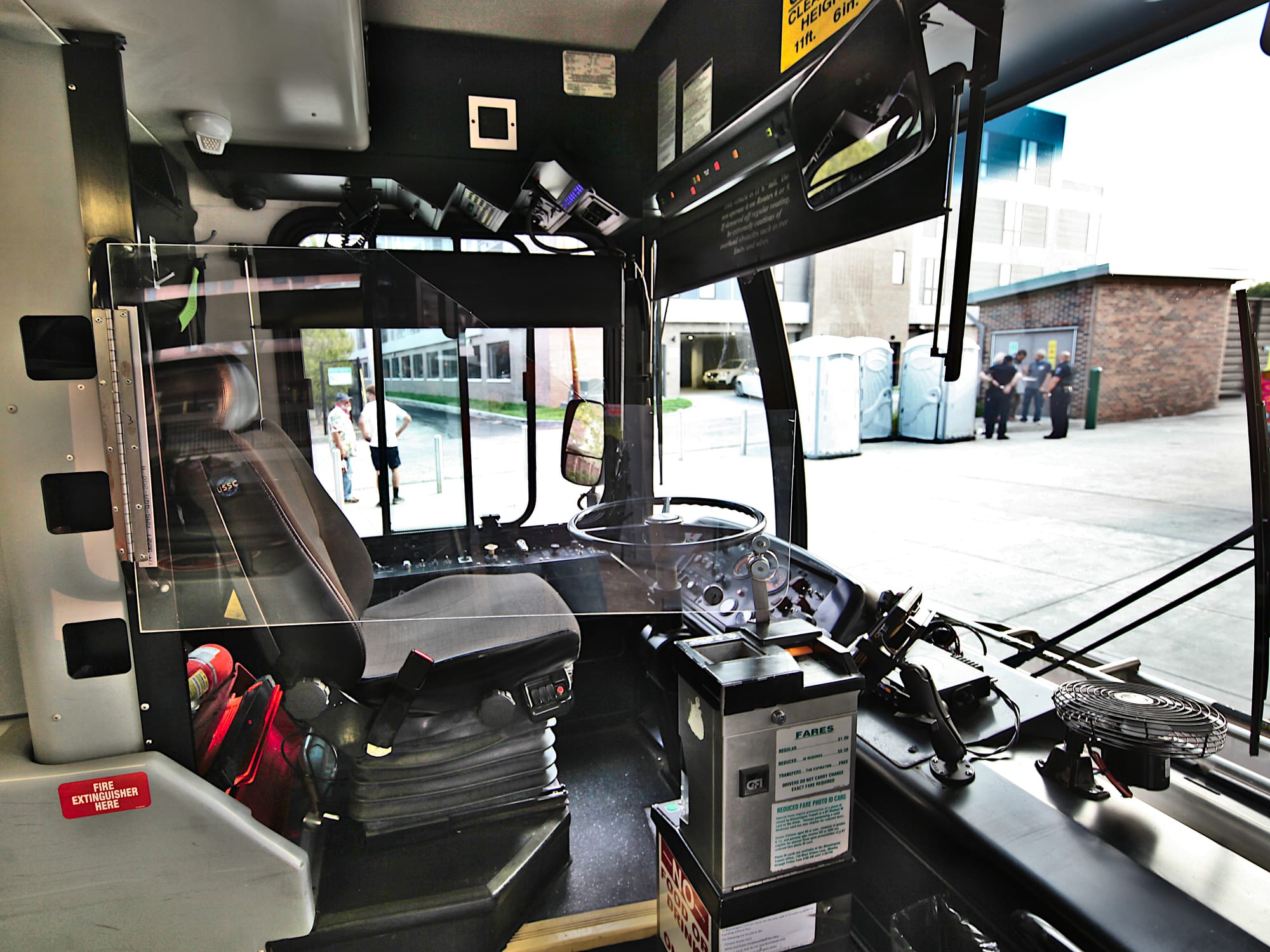COVID-19 means continued lower ridership, fare-free policy for Bloomington public buses



On Tuesday, at its regular monthly meeting, the Bloomington Transit board approved an extension of BT’s fare-free policy through Oct. 20.
The fare-free policy started in March, along with rear-door boarding, as a way to reduce passenger-driver interactions and help prevent the spread of COVID-19. The regular fare is $1 a ride.
Passengers can now board through the front door. A plexiglass partition on a hinge has been installed in buses to form a kind of compartment for the drivers, to reduce the chance of COVID-19 transmission.
Also on Tuesday, the latest numbers reported to the Bloomington Transit (BT) board showed the COVID-19 pandemic’s continued impact on ridership. The lower-ridership trend that started just after Indiana University’s spring break in March has continued through the start of classes this fall.
Ridership has shown incremental gains from month to month since April. But the typical big bump in August is absent this year. Bloomington’s public transit ridership in normal years is roughly 70 percent Indiana University affiliates.
In August this year, about 64,000 rides were taken, compared to 199,000 a year ago. Over the last four months, about one-third the number of rides have been taken on fixed-route buses compared to last year.
The lack of the normal big increase shown in August, despite the return of students to campus, was chalked up to the fact that so many classes are offered online that students have little need to travel to classrooms.
Fares cover a small percentage of operating costs. But the fare-free approach has translated into lower revenue for BT. The August financial report presented to the board on Tuesday showed year-to-date revenues down by almost 10 percent—$6.5 million this year compared to $7.2 million last year.
Historically, Indiana University has paid about $1 million a year to BT to cover the cost of rides by university affiliates—students, faculty and staff. This year that agreement is being re-negotiated to reflect ridership during the pandemic period.
No new COVID-19 cases have been reported among BT drivers or other staff, according to BT general manager Lew May. In early August, a BT driver tested positive for COVID-19.
Other policies extended through Oct. 20 by the board’s Tuesday vote include continued closure to the public of the indoor passenger waiting area of the downtown transit center. That includes bathrooms. Portable restrooms have been set up at the downtown center. Also continued as polices by the board’s vote on Tuesday were: closure of the Grimes Lane facility to the public; and continued remote working for designated administrative and management employees.
Not getting explicit discussion by the board at its Tuesday meeting was Wednesday’s planned vote by the Bloomington city council on a possible quarter-point increase to the countywide local income tax.
A half-point increase pitched by Bloomington mayor John Hamilton at the start of the year had included a plan to spend around $4 million annually on expanded transit service. The current quarter-point proposal includes just $25,000 annually to support public transit, for bus stops improvements.
During a late August episode of WFIU’s Noon Edition, Hamilton said, “I have to say the transit system is in such tumultuous times that—how many people are riding it in their future?… So if you pull that half out [that would have gone to public transit], that leaves 0.25, which I still believe is a very important investment to move us in these directions.”
At Tuesday’s board meeting BT general manager Lew May said, “Of course, transit systems are all reeling from the pandemic and the impacts on their ridership and their revenue. I think everyone is concerned about the impact on ridership and revenue.”
May added, “I think everyone’s in agreement that there’s not going to be a quick return to normal. The pandemic effects are likely going to be several years and perhaps even longer.” May repeated a sentiment he’s expressed before: “Mass transit and social distancing aren’t terms that are very compatible.”
The other talking point for Hamilton on the the current income tax proposal’s lack of significant transit funding is the $7.8 million in funding from the Coronavirus Aid, Relief, and Economic Security (CARES) Act that BT has received through the Federal Transit Administration.
It looks unlikely the $7.8 million can help fund expansion of transit services. It’s meant to shore up losses. At Tuesday’s board meeting, May said, “The CARES Act funding has certainly provided a shot in the arm for most transit systems. But again, that’s a temporary measure that funding is going to be exhausted at some point.”
BT is tapping $4.6 million of the $7.8 million in CARES Act funding to balance the 2021 budget. Responding to a query from The Square Beacon, May said that as much as $2 million in CARES Act funding could be used in 2020 for net operating expenses.
Asked to comment generally on the idea that the CARES Act money would be sufficient to fund fare-free rides or other route/service expansions, May said, “CARES Act funding is flexible and ‘one-time’ in nature. Whatever new services that it may be used for would need a replacement funding source once the CARES Act funding is exhausted.”
May added, “For that reason, it’s not prudent in my view to rely on ‘one-time’ funding to expand services unless reliable replacement funding is there to replace CARES Act funding after it is exhausted.”
At Tuesday’s board meeting, May said he thinks the impact from COVID-19 on public transit systems in college communities will be greater: “In a college community such as Bloomington, I think the impact is going to be greater, because the university environments have changed tremendously as a result of classes going online.” May added, “I think college communities will be more greatly impacted than the non-college communities.”




Comments ()